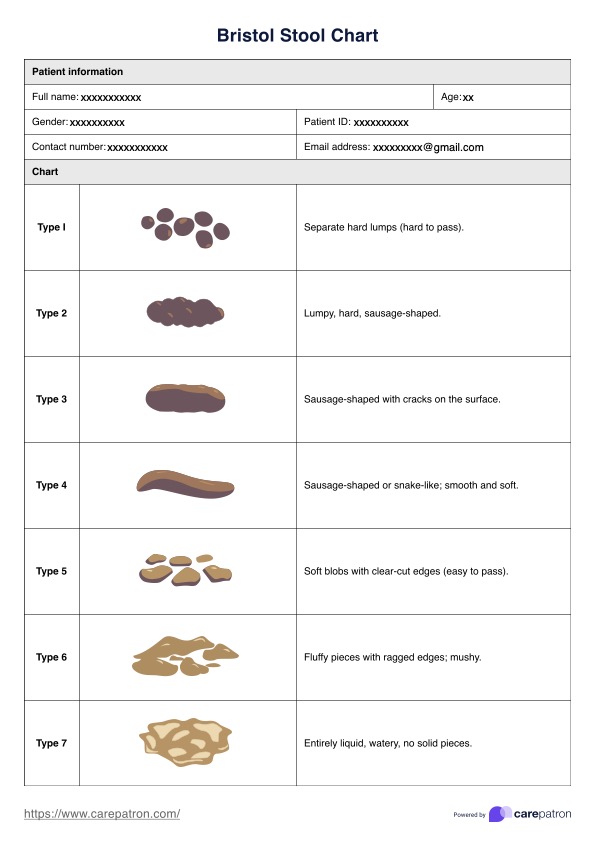Bristol Stool Chart
Use our Bristol Stool Chart to help your patients identify problems with their gastrointestinal health through their stool color and shape.


What is a Bristol Stool Chart?
The Bristol Stool Chart or Bristol stool scale is a clinical tool healthcare professionals utilize to evaluate bowel movements by categorizing them based on their shape and consistency. This chart is instrumental in diagnosing various gastrointestinal conditions, like irritable bowel syndrome, helping to identify whether the stool falls within the normal range or indicates potential health issues.
The chart is divided into seven distinct types:
- Type 1: These stools are characterized by separate hard lumps, which are often difficult to pass and are typically associated with severe constipation.
- Type 2: These stools are lumpy and shaped like sausages, also indicating constipation, but to a slightly lesser degree than Type 1.
- Type 3: These stools have a sausage shape with cracks on the surface, suggesting normal stools but possibly leaning towards the harder side.
- Type 4: These stools are smooth and soft with a sausage or snake-like shape and are considered ideal and indicative of healthy stools and bowel function.
- Type 5: These stools appear as soft blobs with clear-cut edges, which are easy to pass and might suggest a tendency towards loose stools.
- Type 6: These stools are fluffy with ragged edges and have a mushy stool consistency, often indicating mild diarrhea.
- Type 7: These stools are entirely liquid with no solid pieces, a clear sign of diarrhea.
Monitoring changes in bowel habits is crucial to identify bowel habits, improve bowel health, care for the digestive system, and maintain gastrointestinal health, and the Bristol poop chart serves as a valuable tool in this ongoing assessment.
Bristol Stool Chart Template
Bristol Stool Chart Example
How to use our Bristol Stool Chart template
Here's a step-by-step guide on using the Bristol Stool Chart template in your practice:
Step 1: Obtain the Bristol Stool Chart template
To ensure you have a clear and comprehensive copy of the bowel movement chart, download a copy through the links and buttons in this guide.
Step 2: Review the stool types
You and your patients should familiarize yourselves with the seven stool types described in the Bristol stool form scale.
Step 3: Observe stool
After a bowel movement, have the patient observe the stool shape and consistency of their stool.
Step 4: Compare with the chart
Ask the patient to compare their stool with the descriptions and images provided in the Bristol chart and determine which type closely resembles their stool.
Step 5: Record the type and assess the frequency
Ask the patient to document the identified stool type in the template. This record should include the date and any relevant notes about their diet, hydration, or any symptoms experienced over a period of time. This data can help identify patterns or changes in bowel habits.
Step 6: Analyze the information
Analyze and interpret the information given to you by your patient. Here's a quick overview of what the results may mean:
- Types 1 and 2: Your patient may have constipation.
- Types 3 and 4: Your patient has normal stool types indicating healthy poop or healthy bowel movement.
- Types 5, 6, and 7: Your patient has loose to liquid stools, indicating mild to severe diarrhea.
Once analyzed, it's best to diagnose their potential gastrointestinal issues so you may formulate guiding treatment plans to help them.
How healthcare professionals can benefit from this chart
The Bristol Stool Chart offers numerous benefits in assessing bowel health, serving as a valuable tool for patients and healthcare providers. Here's a list of those benefits:
- Self-awareness: The chart enables individuals to identify and monitor changes in a patient's stool patterns, which can signal underlying health issues.
- Improved communication: The chart lets patients accurately describe their stool consistency, ensuring more precise and effective discussions during medical consultations.
- Help identify conditions: The chart is instrumental for healthcare providers in identifying conditions such as constipation, diarrhea, and irritable bowel syndrome (IBS) and provides a standardized method for evaluating bowel movements.
- Treatment monitoring: The chart allows for the tracking of treatment effectiveness over time, enabling healthcare providers to make necessary adjustments to interventions based on documented stool patterns.
- Facilitate early detection: The chart supports preventive measures by facilitating early detection of abnormal stool patterns. Recognizing these changes promptly allows for timely preventive actions, potentially averting more severe gastrointestinal issues.
Commonly asked questions
The ideal types are Type 3 and Type 4, which indicate normal poop.
Warning signs are shapes reminiscent of pebbles/rocks or thin sticks, colors that aren't brown or dark green, grease, and the presence of a foul smell.
Even if a healthy bowel movement varies depending on the person, generally, a healthy bowel movement schedule can be anywhere from 3 times a day to 3 times a week.







































































































